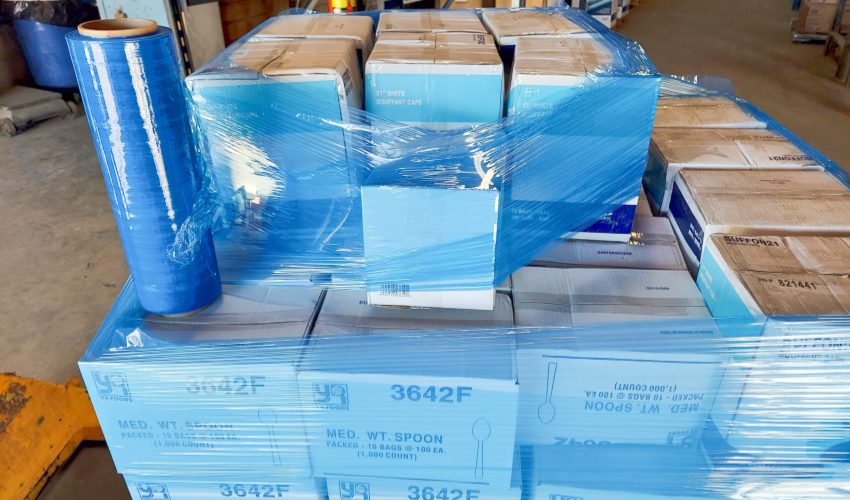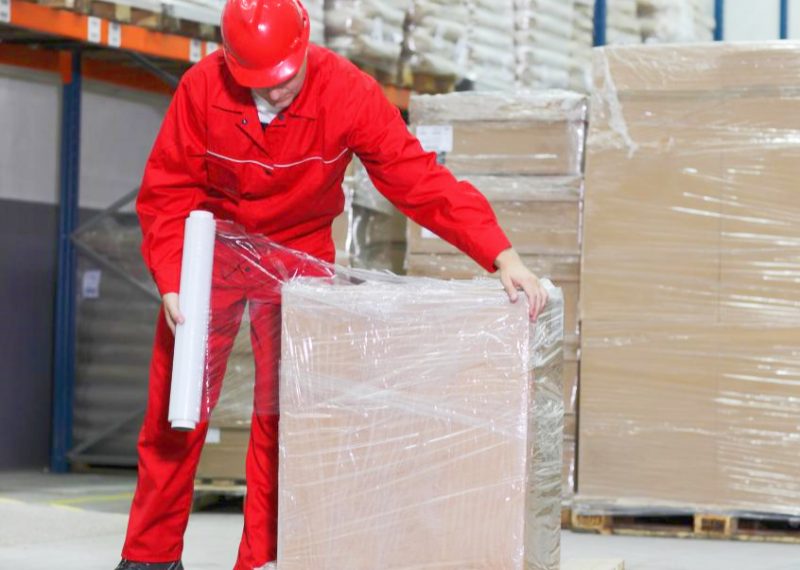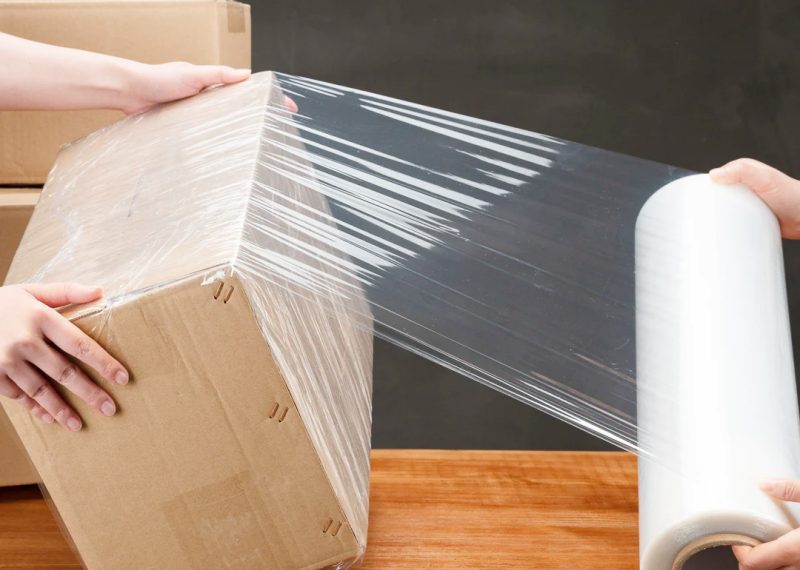
Did you know that U.S. logistics companies lose over $1.2 million annually due to damaged goods from inadequate pallet wrapping?
As a procurement manager or warehouse operator, choosing the right bulk stretch wrap isn’t just about finding the cheapest roll – it’s a critical decision impacting your bottom line. A single pallet collapse from subpar film can cost $400+ in product loss, not to mention delayed shipments and customer complaints.
Yet with endless options claiming “high durability” or “lowest prices”, how do you balance cost efficiency with unshakable load stability? Worse, 63% of buyers overpay for thicker gauges they don’t actually need, according to a 2024 Packaging Digest report. How to slash annual packaging costs by 18% through smart bulk buying strategies. Let’s transform how you protect shipments – and profits.”*
Stretch wrap, a critical material for securing and protecting goods during storage and transportation, is widely used in industries like logistics, manufacturing, and retail. Purchasing stretch wrap wholesale is a strategic way to reduce costs while maintaining quality and efficiency. Below is a detailed breakdown of factors that make wholesale stretch wrap cost-effective:
Stretch wrap is typically made from linear low-density polyethylene (LLDPE), known for its durability, elasticity, and puncture resistance. Key types include:
Cost-Saving Insight:
Wholesale buyers can select the optimal type (e.g., pre-stretched wrap) to minimize waste and labor costs. For example, pre-stretched films require less physical effort and reduce film consumption by up to 50%.
Purchasing in bulk directly from manufacturers or distributors significantly lowers the cost per unit.
To evaluate true cost-effectiveness, consider:
Example:
A 200savings on100 rolls may seemminor,but combined with a2010,000 for a mid-sized warehouse.
Wholesale stretch wrap offers substantial cost savings through bulk pricing, optimized material efficiency, and streamlined operations. By selecting the right type, thickness, and supplier, businesses can achieve a balance between affordability and performance, ultimately enhancing their bottom line. Prioritize TCO over upfront price alone to maximize long-term value.
Choosing between machine-grade and hand stretch film depends on factors like volume, labor costs, equipment investment, and operational efficiency. Below is a detailed cost comparison to help determine the most cost-effective option for your business:
Example:
Wrapping 100 pallets/day manually could cost 150inlabor(at150inlabor(at15/hour), while a machine reduces labor to $50. Film savings from precise machine application offset higher per-roll costs.
| Factor | Machine Film | Hand Film |
|---|---|---|
| Upfront Costs | High (equipment + film) | Low (film only) |
| Labor Costs | Low | High |
| Film Efficiency | High (less waste) | Moderate to Low |
| Product Damage Risk | Low | Higher |
| Scalability | Excellent for high volume | Limited to low volume |
Break-Even Analysis:
A $10,000 machine pays for itself in 6–12 months for a warehouse wrapping 100+ pallets/day, factoring in labor and film savings.
Machine stretch film is more cost-effective for high-volume operations due to labor savings, reduced waste, and better load security. Hand stretch film suits smaller businesses with limited budgets or irregular needs. Conduct a TCO analysis based on your pallet volume, labor rates, and product fragility to make an informed decision. For most warehouses, automating with machine film delivers long-term savings despite higher upfront costs.

Accurately determining your stretch wrap requirements ensures cost efficiency, minimizes waste, and guarantees proper load stability. Below is a detailed method to calculate your needs based on volume, pallet size, stretch film specifications, and operational factors.
Start by collecting the following information:
Use the formula:Film Length per Layer=Pallet Perimeter×(1+Overlap Percentage)Width of Film RollFilm Length per Layer=Width of Film RollPallet Perimeter×(1+Overlap Percentage)
Multiply the film length per layer by the number of layers:Film per Pallet=Film Length per Layer×Number of Layers
If using pre-stretched film (common in machine systems), reduce film usage by the pre-stretch ratio (e.g., 250% pre-stretch reduces film needed by 60%):Adjusted Film per Pallet=Film per PalletPre-Stretch RatioAdjusted Film per Pallet=Pre-Stretch RatioFilm per Pallet
Total Film Required=Film per Pallet×Number of PalletsTotal Film Required=Film per Pallet×Number of Pallets
Stretch wrap rolls are sold by length (feet or meters) and weight. Check roll specifications (e.g., 1,500 ft per roll).Rolls Needed=Total Film RequiredFilm per RollRolls Needed=Film per RollTotal Film Required
Account for:
Adjusted Rolls=Rolls Needed×(1+Waste % + Safety %)
Calculating stretch wrap needs involves measuring film usage per pallet, scaling to total volume, and adjusting for waste and safety margins. Regular testing and monitoring ensure accuracy, while bulk purchasing and optimized machine settings maximize cost savings. Use this method to reduce expenses by 10–30% and maintain reliable load containment.

Choosing the right packaging material depends on load type, cost, durability, and operational efficiency. Below is a detailed comparison of bulk stretch wrap, shrink wrap, and strapping bands, including cost analysis, strengths, and ideal use cases.
| Factor | Bulk Stretch Wrap | Shrink Wrap | Strapping Bands |
|---|---|---|---|
| Primary Use | Stabilizing palletized loads | Sealing and weatherproofing products | Securing heavy or rigid loads |
| Material Cost | 10–50 per roll (wholesale) | 20–100 per roll (varies by size/thickness) | 0.10–1.00 per band (steel, plastic, PET) |
| Equipment Cost | Low (manual dispensers) to moderate (machines) | High (heat tunnels, guns:500–10,000+) | Moderate (tensioners/sealers:50–500+) |
| Labor Efficiency | Fast (machine) to moderate (manual) | Slow (requires heating/cooling time) | Moderate (requires skilled application) |
| Load Stability | High (conforms to irregular shapes) | High (tight seal, tamper-proof) | Very high (for heavy/rigid loads) |
| Weather Resistance | Moderate (UV-resistant options available) | Excellent (waterproof, UV-resistant) | Low (unless coated) |
| Reusability/Recycling | Recyclable LLDPE; single-use | Recyclable LDPE/PVC; single-use | Reusable (steel) or recyclable (plastic/PET) |
| Best For | Irregular shapes, medium-weight pallets, high volume | Small items, retail packaging, moisture-sensitive goods | Heavy machinery, bricks, lumber |
Strengths:
Weaknesses:
When It Wins:
Strengths:
Weaknesses:
When It Wins:
Strengths:
Weaknesses:
When It Wins:
Bulk stretch wrap dominates in high-volume, cost-sensitive operations with medium-weight, irregular loads. Shrink wrap excels in weatherproofing and retail packaging, while strapping bands are unmatched for heavy industrial goods. Evaluate your load type, budget, and operational scale to choose the optimal solution—or combine methods for maximum security and savings.
Purchasing bulk stretch wrap requires balancing cost, performance, sustainability, and reliability. Below is a detailed breakdown of the critical factors to optimize your decision:
Key Considerations:
Cost-Saving Tip:
Calculate cost per pallet instead of per roll. For example:
Critical Metrics:
Case Study:
A logistics company switched from 200% to 300% pre-stretch film, cutting annual film consumption by 20% (saving $12,000/year on 50,000 pallets).
Performance Checklist:
Sustainable Choices:
| Material | Cost Premium | Benefits | Drawbacks |
|---|---|---|---|
| 30% PCR Stretch Wrap | +15–25% | Reduces virgin plastic use | Slightly lower tear strength |
| Biodegradable Film | +50–100% | Breaks down in 2–5 years (ASTM D5511) | Higher cost, shorter shelf life |
Certifications to Look For:
How to Vet Suppliers:
Red Flags:
Key Factors:
Example:
A retailer saved 15% on logistics by ordering semi-annually and using a regional supplier with 2-day delivery.
Choosing bulk stretch wrap involves analyzing cost per pallet, film performance metrics, eco-friendly alternatives, supplier trustworthiness, and logistics flexibility. For most businesses, investing in high pre-stretch film from an ISO-certified supplier offers the best balance of savings and reliability. Always test samples and negotiate MOQ tiers to maximize value.

When purchasing bulk stretch wrap, it’s essential to understand the different types available to ensure you’re using the right product for your needs. Each type of stretch wrap has unique characteristics that make it suited for specific applications, from standard packaging to specialized requirements.
| Type of Stretch Wrap | Characteristics | Benefits | Uses |
|---|---|---|---|
| Cast Stretch Wrap | Excellent clarity, quiet application, lower costs | Allows easy content identification; economical option | Standard packaging for uniform loads |
| Blown Stretch Wrap | Higher puncture resistance, strong cling, durable | Ideal for irregular or heavy loads; superior hold | Heavy-duty packaging for challenging shapes |
| Specialty Wraps | UV-protected, colored/opaque, pre-stretched for reduced worker fatigue | Specific use cases: outdoor storage, security, worker ease | Outdoor storage, sensitive items, high-volume operations |
Customizing bulk stretch wrap ensures it aligns perfectly with your operational needs, load requirements, and sustainability goals. Below are key customization options available from most suppliers, along with their benefits and use cases.
Options:
Example:
A furniture manufacturer uses 25-micron film to protect wooden pallets with metal brackets, reducing damage claims by 15%.
Customization:
Case Study:
A beverage distributor uses 24″ wide rolls on automated machines to wrap 60+ pallets/hour, cutting labor time by 40%.
Options:
Why It Matters:
A 3PL company saved $8,000/year by switching to 250% pre-stretch film, maintaining load stability while using fewer rolls.
Customization:
Cost:
Customizing bulk stretch wrap allows businesses to optimize costs, enhance load security, and meet sustainability targets. Key options include adjusting thickness, pre-stretch rates, eco-friendly materials, and specialty features like anti-static properties. Partner with suppliers offering ISO-certified customization and sample testing to ensure the film meets your unique needs. For example, combining 250% pre-stretch with 30% PCR content can cut costs by 25% while supporting ESG goals. Always balance customization premiums with long-term savings from reduced waste and damage.
Purchasing bulk stretch wrap offers a range of advantages for businesses focused on efficient, cost-effective packaging solutions. Whether a business handles frequent shipments, needs to secure inventory, or requires consistent packaging materials on hand, buying in bulk provides multiple benefits.
One of the primary benefits of buying bulk stretch wrap is cost-effectiveness. Businesses with high packaging demands can significantly lower their per-unit costs by purchasing in bulk. Bulk purchases often come with wholesale discounts, helping businesses stretch their packaging budgets further. This approach also reduces the frequency of reordering, cutting down on administrative costs and saving on shipping fees that might accumulate with smaller, frequent orders. For high-volume operations, these cost savings can quickly add up, making stretch wrap in bulk a financially smart choice.
Ensuring a steady supply of stretch wrap is critical for businesses that rely on secure packaging to protect their products. Buying bulk stretch wrap allows businesses to maintain a consistent stock of materials, reducing the risk of running out during peak periods. With bulk quantities, packaging operations can continue smoothly without the downtime associated with waiting for new orders to arrive. This uninterrupted availability ensures that businesses can meet deadlines, improve productivity, and avoid costly delays due to supply shortages.
Buying bulk stretch wrap does not mean sacrificing variety; in fact, it often provides access to a broader selection of options tailored to different packaging needs. Bulk orders usually allow businesses to choose from a wide array of stretch wrap types, sizes, and thicknesses, such as cast, blown, or specialty wraps, depending on specific requirements. This flexibility ensures that businesses can stock the ideal stretch wrap for various applications—whether they need durable, puncture-resistant wrap for irregular loads or clear, economical wrap for everyday packaging. Access to this variety ensures that businesses have the right tool for any job, enhancing both efficiency and product protection.

Finding the right bulk stretch film wholesale distributors is essential for securing affordable and reliable packaging materials. Below are some tips to guide you in selecting a distributor that meets your business needs.
Local distributors offer the advantage of reduced shipping costs and faster delivery. Searching for “bulk stretch film wholesale distributors near me” online is an excellent starting point. Additionally, reaching out to industry peers or trade organizations can provide recommendations for trusted local distributors. Many companies also offer consultations to help businesses determine the best stretch wrap options and quantities based on usage.
When sourcing cheap bulk stretch wrap from wholesale distributors, it’s essential to balance affordability with quality, especially when considering options like warehouse stretch wrap. This type of wrap offers reliable performance for securing loads while still being cost-effective for large-volume packaging needs. Look for established suppliers with positive reviews who prioritize durability and consistency. Cheaper options are available, but it’s important to verify that the materials meet your required performance standards, especially for heavy-duty or sensitive loads. Reputable wholesalers often offer sample rolls or trial runs to ensure the quality aligns with your packaging requirements.
Several factors come into play when evaluating bulk stretch wrap for sale from different distributors. Begin by comparing product specifications, such as gauge, size, and type, to confirm compatibility with your load requirements. Look for distributors that offer competitive bulk pricing, and check for minimum order quantities that align with your usage needs. Customer support is also vital—reliable distributors should provide timely assistance, answer questions, and address issues efficiently, ensuring a seamless purchasing experience.
Choosing the right supplier ensures quality, reliability, and cost savings. Use this checklist to assess potential vendors systematically.
✅ ISO 9001: Ensures consistent quality management systems.
✅ ISO 14001: Validates environmental responsibility (if sustainability is a priority).
✅ Industry-Specific Certifications:
✅ Material Testing Reports:
✅ Clear Pricing Tiers:
✅ Lead Times:
✅ Responsiveness:
✅ Recycled Content:
❌ No sample testing allowed.
❌ Vague or inconsistent pricing.
❌ Lack of certifications or safety documentation.
❌ Negative reviews citing delayed shipments or poor film quality.
A mid-sized logistics company evaluated three suppliers using this checklist:
A high-scoring supplier balances cost, quality, and service reliability. Prioritize ISO-certified vendors with transparent pricing, strong customer support, and scalability. Use this checklist to shortlist 2–3 suppliers, conduct trials, and negotiate terms that align with your operational needs. For example, a warehouse prioritizing sustainability might accept a 20% cost premium for 50% PCR film, while a cost-focused 3PL may prioritize bulk discounts and pre-stretch.
The thickest stretch wrap commonly available on the market is 120 gauge, though even thicker options can be custom ordered if needed. Thicker stretch wraps, such as those at 100 or 120 gauge, are typically used for heavy-duty applications where products require a higher level of protection. These thick wraps are puncture-resistant and offer superior load containment, which makes them ideal for heavy, irregular, or sharp-edged items that might otherwise tear through standard stretch wrap. While a standard 80-gauge wrap is sufficient for most loads, choosing a thicker wrap is essential when shipping or storing items that are unusually heavy or at a high risk of damage. Businesses in industries like manufacturing or construction often rely on thicker stretch wraps for these more challenging packaging needs.
The amount of stretch wrap needed per pallet can vary based on several factors, including the size of the pallet, the type of load, and the thickness and width of the stretch wrap being used. On average, it takes between 100 to 150 feet of stretch wrap to wrap a standard pallet securely. For pallets with irregular or heavy items, more wrap may be needed to provide stability and prevent movement during transport. Pre-stretched wrap, which has already been extended, might reduce the amount required, as it provides good load containment with fewer wraps around the pallet. Using the right amount of stretch wrap per pallet is crucial for ensuring the safety of the load while optimizing material use and keeping packaging costs efficient.
Stretch wrap and stretch film refer to the same type of packaging material used to secure items during transit and storage, but they are often used interchangeably based on regional or industry-specific terminology. Both terms describe a flexible plastic film that adheres tightly around products or pallets, providing a protective barrier that holds items together. Stretch wrap is typically made from linear low-density polyethylene (LLDPE), a material known for its flexibility and strength. While stretch wrap is often used to refer to hand-applied films, stretch film may also encompass machine-applied films used in automated wrapping equipment. Whether referred to as stretch wrap or stretch film, the material serves the same purpose: securing items and protecting them from shifting, dirt, and moisture.
Hand wrap and stretch wrap essentially describe two different applications of the same material. Hand wrap, as the name suggests, is specifically designed to be applied manually. This wrap usually comes in smaller rolls that are easy to handle and apply by hand, making it ideal for low to moderate packaging needs where speed and flexibility are essential. Hand wrap is often used for smaller warehouses or businesses where items are packaged on-demand. Stretch wrap, on the other hand, is a broader term that includes both hand wrap and machine wrap. Machine wrap, as opposed to hand wrap, is designed for use in automated or semi-automated stretch wrap machines that can apply the wrap more quickly and consistently across multiple pallets. For high-volume operations, machine stretch wrap can save considerable time and reduce worker fatigue. Ultimately, the choice between hand wrap and machine wrap (under the stretch wrap category) depends on the volume of packaging and the resources available to the business.
Yes, a stretch wrap is worth it, especially for securing and protecting goods during transportation or storage. It helps prevent damage caused by shifting or exposure to dust, moisture, or other environmental factors. Stretch wrap is cost-effective and easy to use, making it ideal for businesses handling large quantities of products. It also enhances stability, keeping items tightly bound on pallets. For smaller-scale uses, it is just as beneficial for bundling or protecting smaller items. Its versatility and ability to reduce waste by minimizing product damage make it a valuable tool for any supply chain.
The cost of pallet wrap varies depending on its size, thickness, material, and brand. Generally, a standard roll of stretch wrap can cost between $10 and $50, with larger industrial-grade rolls costing more. Factors like pre-stretched or reinforced material may also impact the price. For businesses that purchase in bulk, prices may be lower per roll. Reusable or eco-friendly options are typically more expensive but may offer better long-term value. To find the best deal, compare prices based on your specific needs, such as load size and frequency of use.

My name is James Thompson, and I’m the editor of this website dedicated to Stretch Film, Pallet Wrap, and Stretch Wrap products.
My passion for packaging began when I noticed the challenges companies face in securing their products efficiently for transportation and storage. This inspired me to delve deep into the world of stretch films and pallet wraps, exploring the latest technologies and best practices.
I aim to provide valuable insights, practical tips, and up-to-date industry trends to assist you in making informed decisions. Whether you’re a small business owner or part of a large corporation, my goal is to support you in optimizing your operations and ensuring your products reach their destination safely.
Thank you for visiting, and I look forward to accompanying you on your journey toward better packaging solutions.
Comments are closed